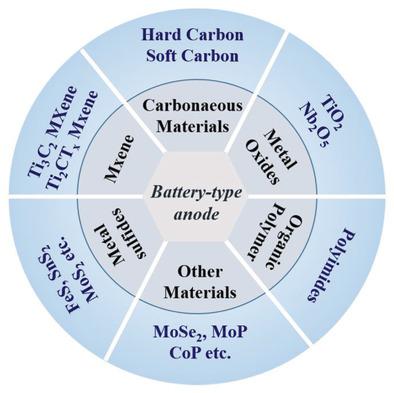当前位置:
X-MOL 学术
›
Small Methods
›
论文详情
Our official English website, www.x-mol.net, welcomes your
feedback! (Note: you will need to create a separate account there.)
Advanced Battery‐Type Anode Materials for High‐Performance Sodium‐Ion Capacitors
Small Methods ( IF 10.7 ) Pub Date : 2020-09-02 , DOI: 10.1002/smtd.202000401 Xinglan Deng 1 , Kangyu Zou 1 , Peng Cai 1 , Baowei Wang 1 , Hongshuai Hou 1 , Guoqiang Zou 1 , Xiaobo Ji 1
Small Methods ( IF 10.7 ) Pub Date : 2020-09-02 , DOI: 10.1002/smtd.202000401 Xinglan Deng 1 , Kangyu Zou 1 , Peng Cai 1 , Baowei Wang 1 , Hongshuai Hou 1 , Guoqiang Zou 1 , Xiaobo Ji 1
Affiliation

|
High‐efficiency energy storage technologies and devices have gained numerous attention because of their ever‐increasing requirement. Sodium‐ion capacitors (SICs), as a burgeoning electrochemical energy storage device, combine virtues of rechargeable batteries and electrochemical double layer supercapacitors, delivering both high energy–power density and long cycling life. In the past decades, great efforts have been made to find suitable anode material to conquer the kinetic imbalance between the battery‐type anode with sluggish bulk redox reaction and the capacitor‐type cathode with fast ion absorption/desorption process. By exploring high‐rate performance anode materials, the great reaction kinetic gap between cathodes and anodes can be narrowed down, which directly affects the energy–power densities of SICs. In this article, an overview of advanced battery‐type anode materials is offered for high‐performance SICs with an emphasis on anode structural design and improved energy–power density, including carbonaceous materials, metallic compounds, MXene, organic polymers, and so on. Furthermore, the implementation of presodiation for the sake of optimizing the SICs is also illustrated. Finally, the challenges faced and the perspectives for future developing trends of SICs are discussed.
中文翻译:

适用于高性能钠离子电容器的高级电池型阳极材料
高效能存储技术和设备由于其不断增长的需求而受到了广泛的关注。钠离子电容器(SIC)作为新兴的电化学能量存储设备,结合了可充电电池和电化学双层超级电容器的优点,既提供了高能量-功率密度,又具有长循环寿命。在过去的几十年中,人们一直在努力寻找合适的阳极材料,以克服缓慢的本体氧化还原反应引起的电池型阳极与具有快速离子吸收/解吸过程的电容器型阴极之间的动力学失衡。通过探索高性能阳极材料,可以缩小阴极和阳极之间的巨大反应动力学间隙,这直接影响了SIC的能量密度。在这篇文章中,针对高性能SIC提供了先进的电池型负极材料的概述,重点是负极结构设计和改进的能量密度,包括碳质材料,金属化合物,MXene,有机聚合物等。此外,还说明了为了优化SIC而进行的预生成。最后,讨论了SIC面临的挑战和未来发展趋势的前景。
更新日期:2020-10-07
中文翻译:

适用于高性能钠离子电容器的高级电池型阳极材料
高效能存储技术和设备由于其不断增长的需求而受到了广泛的关注。钠离子电容器(SIC)作为新兴的电化学能量存储设备,结合了可充电电池和电化学双层超级电容器的优点,既提供了高能量-功率密度,又具有长循环寿命。在过去的几十年中,人们一直在努力寻找合适的阳极材料,以克服缓慢的本体氧化还原反应引起的电池型阳极与具有快速离子吸收/解吸过程的电容器型阴极之间的动力学失衡。通过探索高性能阳极材料,可以缩小阴极和阳极之间的巨大反应动力学间隙,这直接影响了SIC的能量密度。在这篇文章中,针对高性能SIC提供了先进的电池型负极材料的概述,重点是负极结构设计和改进的能量密度,包括碳质材料,金属化合物,MXene,有机聚合物等。此外,还说明了为了优化SIC而进行的预生成。最后,讨论了SIC面临的挑战和未来发展趋势的前景。











































 京公网安备 11010802027423号
京公网安备 11010802027423号